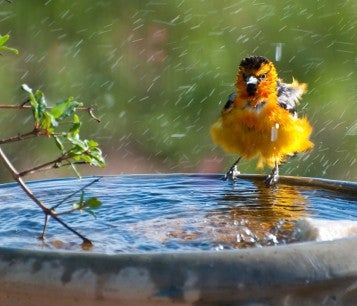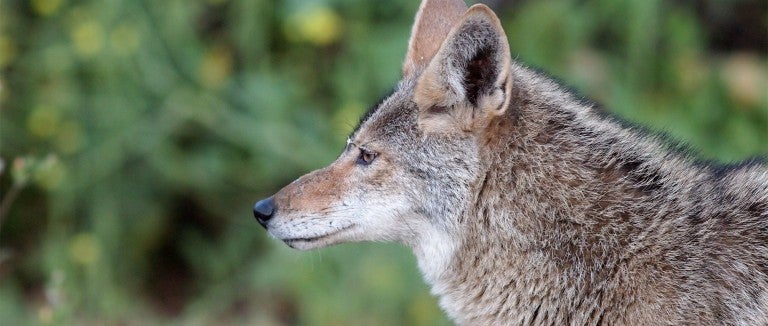If you spot a coyote in your neighborhood, relax: Most coyotes avoid people. “Seeing a coyote out during the day is not a cause for alarm, especially in the spring and summer when they’re out looking for food for their pups,” says Lynsey White, HSUS director of humane wildlife conflict resolution.
Coyotes most often eat rodents, but they’re also happy to eat trash, fallen fruit or bird seed if left unsecured. If a coyote displays no fear of people, they’ve probably been fed by or around humans, and you’ll need to re-teach them to be afraid of you. We can help debunk coyote myths and share some humane techniques that are proven to drive coyotes away.
Contents
No matter how big or small your outdoor space, you can create a haven for local wildlife. By providing basic needs like water, food and shelter, you can make a difference in your own backyard.

Should I trap, relocate or kill coyotes?
No. Trapping, relocating or killing coyotes is inhumane and ineffective for the following reasons:
-
Traps/snares are cruel and can cause collateral damage: The most common devices used to capture coyotes are leg-hold traps and neck snares. Both can cause severe injuries, pain and suffering. Pets become unintended victims of traps set for coyotes. An informal search of media reports suggests thousands of unintended incidents have occurred, causing heartbreak for the families affected. Non-target wild animals are also caught in traps, and many sustain injuries so severe that they die or must be euthanized.
-
Coyote removal is difficult and potentially costly: It’s extremely difficult to ensure that the problem-causing coyote is the one that’s located and killed. Coyotes are intelligent animals and are difficult to catch. Even a skilled trapper or sharpshooter, at a hefty price tag, will need many hours to catch a targeted coyote.
-
Relocating a coyote is often a death sentence: Relocating a coyote is most often a death sentence for that animal; coyotes are very territorial and occupy large home ranges up to 40 square miles. If relocated, they will do almost anything to get back home, and unfamiliar with their new terrain, they are often killed by cars or killed during territorial disputes with coyotes already established in the new area.
-
Coyote populations bounce back quickly: Despite bounties and large-scale efforts to kill coyotes over the last 100 years, coyotes have expanded their range throughout the U.S. and Canada. One study found that killing 75% of a coyote population every year for 50 years would still not exterminate the population. Research suggests that when aggressively controlled, coyotes can increase their reproductive rate by breeding at an earlier age and having larger litters, with a higher survival rate among the young. This allows coyote populations to quickly bounce back, even when as much as 70% of their numbers are removed.
-
When one coyote is removed, another moves in: Coyotes removed from an area will quickly be replaced by others. Coyote pairs hold territories, which leaves single coyotes ("floaters") constantly looking for new places to call home. Kill one or both members of the alpha pair (A)—the only pair who normally reproduces—and other pairs will form and reproduce. At the same time, lone coyotes will move in to mate, young coyotes will start having offspring sooner, and litter sizes will grow.

Do coyotes eat cats, dogs or other pets?
Yes, occasionally. Coyotes may mistake small, unattended pets as prey or attack large dogs they view as threats to territory or dens. To keep your cats and dogs safe, take two simple steps: Keep them inside unless supervised, and feed them inside.
Cats
Coyotes aren't the only threat cats face when they go outside—there are far greater dangers. When you allow your cat to roam freely outdoors, even for short periods of time, you expose them to perils such as cars, dogs, diseases, coyotes, poisons and cruel people. If you want your cat to be safe, keep them indoors.
Some people let their cats outside because they mistakenly believe it's cruel to keep cats indoors. The truth is that cats who are protected from the dangers outside live longer, happier lives. (You'll be helping your neighboring wildlife stay safer and happier as well.) We've got guidelines to help you keep your indoor cat happy.
Feral cats
People who feed feral cats are often concerned that coyotes might prey on the cats. These concerns are well founded, as coyotes will be attracted to both the outdoor pet food and the cats themselves as prey. Here are some general suggestions for keeping such cats safer:
- Feed cats only during the day and at a set time, and pick up any leftovers.
- Provide escape routes for cats.
- Erect "cat posts"—long pieces of wood (four inches by four inches or corner posts) that stand out of the ground at least ten to twelve feet. These can be climbed by cats but not by coyotes.
- Elevate feeding stations beyond coyotes’—but not the cats’—reach.
- Haze any coyotes you see nearby.
Dogs
Dogs (especially small dogs) are also vulnerable to coyote confrontations. These incidents generally involve coyotes who are accustomed or habituated to people (usually due to wildlife feeding) or coyotes who are protecting their territory and pups (usually during breeding season).
Dogs (especially small dogs) should not be left outside unattended, should never be chained and should always be kept on a leash in public areas. It is important to never let your dog interact or play with a coyote. Pet food and water should be kept indoors to avoid attracting coyotes to your yard.
Although “attacks” on larger dogs are rarer, coyotes will sometimes go after a large dog when they feel that their territory is threatened. This generally occurs during the coyote breeding season, which takes place from January through March. During this time, it is especially important not to let dogs outside unattended and to keep them on leashes when in public areas.
Chickens and rabbits
As prey animals with few defenses, chickens and rabbits are highly vulnerable to a plethora of predators, including but not limited to coyotes, foxes, raccoons and hawks. Always protect poultry and other outdoor animals from coyotes (and other predators) with protective fencing (both structural and electric) and by ensuring that they are confined in sturdy cages or pens until after dawn and before dusk.
What keeps coyotes away? How can I deter or haze coyotes?
Never run from a coyote. The most effective method for handling and preventing conflicts with coyotes is to remove food sources and implement hazing techniques.
Remove food sources
Deliberately feeding coyotes is a mistake. You may enjoy hand-feeding animals, but this is a surefire way to get them accustomed to people and will ultimately lead to their demise. Here are some other general rules about feeding:
-
Avoid feeding pets outside. If you must, feed them only for a set time during the day (for no more than one hour) and remove the food bowl as soon as your pet has finished his or her meal.
-
In dry conditions, water can be as alluring as food, so remove water bowls set outside for pets and make watering cans unavailable.
-
If you compost, use enclosed bins, and never compost meat or fish scraps.
-
Use no-spill bird feeders and spicy bird seed.
-
Remove fallen fruit and bird seed from the ground.
-
Keep trash in high-quality containers with tight-fitting lids.
Implement hazing techniques
Following a variety of hazing guidelines [PDF] is critical so that coyotes don’t get used to redundant or single stimulus devices, sounds and actions.
-
Yelling and waving your arms while approaching the coyote
-
Noisemakers: Voice, whistles, air horns (you can purchase small air horn necklaces for dog walks), bells, “shaker” cans full of marbles or pennies, pots, lid or pie pans banged together
-
Projectiles: sticks, small rocks, cans, tennis balls or rubber balls
-
Other: hoses, water guns with vinegar water, spray bottles with vinegar water, pepper spray or bear repellent
The coyote may not leave at first, but if you approach them closer and/or increase the intensity of your hazing, they will run away. If the coyote runs away a short distance and then stops and looks at you, continue hazing until they leave the area entirely. After you have successfully hazed a coyote, they may return. Continue to haze the coyote as you did before; it usually takes only one or two times to haze a coyote away for good.
Install fencing
Fencing can be used to keep coyotes out of residential yards, but it must be at least six feet tall and should extend underground at least six inches or be parallel to the ground for at least 12 inches and secured with landscaping staples. Devices such as the "coyote roller,” which “rolls off” coyotes that try to scramble over the fence, can enhance the effectiveness of a fence. Do-it-yourself options also include adding PVC piping or chicken wire to the top of your fence to prevent coyotes from jumping over and retrofitting a mesh apron to the bottom of the fence (extending at least 12 inches out and secured with landscaping staples) to keep coyotes from digging under it.
Do coyote repellents and deterrents work?
Maybe, although the only long-term solution to coyote conflicts is to remove food sources and implement hazing techniques. Solar-powered, motion sensor lights, sounds and sprinklers; bitter or spicy taste deterrents; and smell deterrents such as cayenne pepper, vinegar and ammonia may help deter coyotes if used consistently.
Do coyotes carry disease?
Any warm-blooded mammal can contract rabies. Coyotes with rabies have been found in southern Texas in the past, but rarely in recent years. Don’t approach or handle wild animals, vaccinate your pets and report any animal showing signs of rabies (excessive aggression, agitation, self-mutilation, salivation, partial paralysis, disorientation) to your local animal control. Immediately seek medical treatment for bites or scratches inflicted by unknown animals.
Some coyote trappers claim that coyotes with mange are to blame for pet attack incidents and that removing such animals from the population is the answer. This is not the case. There is no evidence that coyotes with mange are more likely to attack people or pets. Mange-afflicted coyotes can simply appear threatening because they are weak, strange-looking (due to hair loss) and may be found resting in suburban areas during the daytime.

